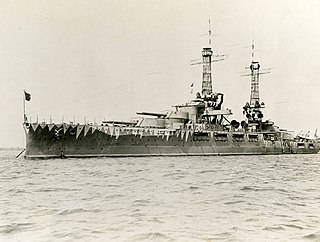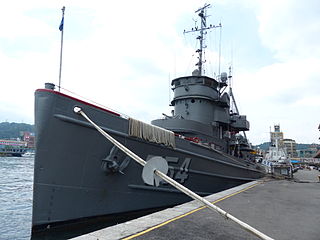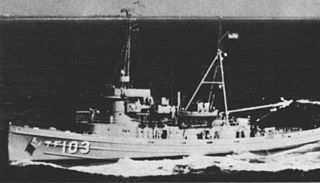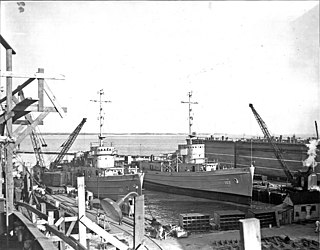
USS Oklahoma (BB-37) was a Nevada-class battleship built by the New York Shipbuilding Corporation for the United States Navy, notable for being the first American class of oil-burning dreadnoughts. Commissioned in 1916, the ship served in World War I as a part of Battleship Division Six, protecting Allied convoys on their way across the Atlantic. After the war, she served in both the United States Battle Fleet and Scouting Fleet. Oklahoma was modernized between 1927 and 1929. In 1936, she rescued American citizens and refugees from the Spanish Civil War. On returning to the West Coast in August of the same year, Oklahoma spent the rest of her service in the Pacific.

USS Abnaki (ATF-96) was the lead ship of the Abnaki class of fleet ocean tugs in the service of the United States Navy, named after the Abenaki tribe of Native Americans. She was laid down on 28 November 1942 at Charleston, South Carolina by Charleston Shipbuilding & Drydock, launched on 22 April 1943, sponsored by Mrs. James Mayon Jones, and commissioned at the Charleston Navy Yard on 25 November 1943. Abnaki earned three battle stars for service during the Korean War and 10 battle stars during the Vietnam War.

USS Achomawi (AT-148/ATF-148) was an Abnaki-class fleet ocean tugs in the service of the United States Navy, and was named for the Achomawi tribe of Native Americans.

USS Munsee (AT/ATF-107) was an Abnaki-class fleet ocean tug. She is the only ship of the United States Navy to hold the name Munsee, which is the name of a subtribe of the Delaware Indians, still living in Wisconsin and Kansas.

USS Pakana (AT–108) was an Abnaki-class fleet ocean tug. It was named after the Pakana, a Native American tribe of Texas. This ship saw service in the Pacific theater of World War II, and was later transferred to the United States Bureau of Mines for use in Alaska before being deliberately sunk in 1975.

USS Quapaw (ATF–110/AT-110) was a Abnaki-class fleet ocean tug in the United States Navy. She was named after the Quapaw.

USS Cahuilla (ATF-152) was an Abnaki class fleet tug in the service of the United States Navy during World War II. In 1961 she was sold to the Argentine Navy as ARA Irigoyen (A-1) where she served until 2009 when she became a Museum ship.

USS Yuma (AT-94/ATF-94/T-ATF-94) was a Navajo-class fleet tugboat constructed for the United States Navy during World War II. She was the second U.S. Navy ship named for the Yuma tribe of Arizona.

USS Wateree (ATF-117/AT-117) was an Abnaki-class fleet ocean tug acquired by the U.S. Navy during World War II. Wateree was sent to the western Pacific Ocean to perform towing services; however, during a typhoon, she was damaged beyond repair and lost, with eight crew members missing.
USS Arapaho (AT-68/ATF-68) was a Navajo-class fleet ocean tug which served the U.S. Navy during World War II with her towing services. She was assigned initially to support the U.S. Atlantic Fleet, and was eventually assigned to support Allied forces in the war zones of the Pacific Ocean, resulting in her crew returning home after the war with four battle stars to their credit.

USS Chimariko (ATF-154) was an Abnaki class Fleet Ocean Tug of the United States Navy and the first to be named Chimariko after the Native American tribe in California.

USS Molala (AT-106/ATF-106) was a US Navy Abnaki-class tugboat, named after the Molala people of Oregon.

The Type V ship is a United States Maritime Commission (MARCOM) designation for World War II tugboats. Type V was used in World War II, Korean War, and the Vietnam War. Type V ships were used to move ships and barges. Type V tugboats were made of either steel or wood hulls. There were four types of tugboats ordered for World War II. The largest type V design was the sea worthy 186-foot (57 m) long steel hull, V4-M-A1. The V4-M-A1 design was used by a number of manufacturers; a total of 49 were built. A smaller steel hull tugboat was the 94-foot (29 m) V2-ME-A1; 26 were built. The largest wooden hull was the 148-foot (45 m) V3-S-AH2, of which 14 were built. The smaller wooden hull was the 58-foot (18 m) V2-M-AL1, which 35 were built. Most V2-M-AL1 tugboats were sent to the United Kingdom for the war efforts under the lend-lease act. The Type V tugs served across the globe during World War II including: Pacific War, European theatre, and in the United States. SS Farallon, and other Type V tugs, were used to help built Normandy ports, including Mulberry harbour, on D-Day, 6 June 1944, and made nine round trips to Normandy to deliver Phoenix breakwaters.

USS Moctobi (ATF-105) was an Abnaki-class of fleet ocean tug. She served in World War II, Vietnam, and Korea, the last two of which she received battle stars. She was scrapped in 2012.

USS Hitchiti (ATF-103) was Abnaki-class tugboat during the World War II, Korea and Vietnam. The ship was later sold to Mexico as ARM Chac (R-55). Her namesake is a tribe of Creek Indians who lived in Florida and Georgia. The word "Hitchiti" means "to look up the stream."

USS Hidatsa (ATF-102) was Abnaki-class tugboat during the World War II. The ship was later sold to Colombia as ARC Rodrigo de Bastidas (RM-74). Her namesake is an Indian group of the Sioux Tribe of North Dakota, now living on the Fort Berthold Reservation.

USS Jicarilla (ATF-104) was Abnaki-class tugboat during the World War II. The ship was later sold to Colombia as ARC Sebastián De Belalcázar (RM-73). Her namesake is a group of the Apache tribe found in the southwestern United States.

USS Mosopelea (ATF-158) was Abnaki-class tugboat during the World War II and Cold War. Her namesake is an Indian tribe which inhabited the area near the junction of the Ohio and Mississippi Rivers.

USS Shakori (ATF-162) is an Abnaki-class tugboat that saw service during the World War II and Cold War. She was later sold to Republic of China as ROCS Da Tai (ATF-563). Her namesake was a small Indian tribe which originally inhabited an area near the present site of Durham, North Carolina.
USS Tolowa (ATF-116) was Abnaki-class tugboat during the World War II. She was later sold to Venezuela as ARV Felipe Larrazábal (R-11). Her namesake is an Athabascan Native American tribe of northwestern California that formerly occupied the coast from the Klamath River to the Oregon border.


















